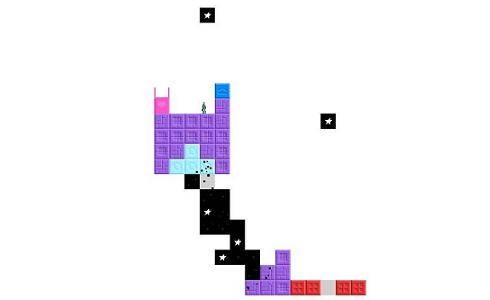An Indie Game Review
You could be forgiven for initially dismissing Starseed Pilgrim as little more than a curiosity. Droqen’s latest endeavor is a strange, abstract title that does little to endear itself to new players; spending ten minutes with the game might leave you with the vague impression that something is missing. Spend an hour with it and you may come to the conclusion that it was designed with the specific purpose to bewilder and confuse its audience.
If you stay a little longer though, you’ll begin to see something compelling and altogether worthy of your time emerge from the blankness.

I Hoped to Find Why the World Wasn’t Glowing
The creation of Alexander Martin a prolific 21-year-old game designer from Toronto, Canada (a city that has proven to be a hotbed for challenging and often boundary-pushing indie fare that includes Analogue: A Hate Story by Christine Love and Home by Benjamin Rivers), Starseed Pilgrim opens with little fanfare; the first area you navigate serves as a stand-in for the usual title screen, providing basic control information along with the title and some credits.
Once this area has been passed through you will arrive in the main hub of the game – a floating cube of blocks suspended in a white void. The game is immediately reminiscent of a 2D platformer only with a hyper-minimalist style.
It is difficult to describe Starseed Pilgrim without giving away too much; the official description at the game’s website offers the following cues:
“You are a gardener, tending to empty noise and empty space to fill them both with colour. You are a refugee, building your own world away from the spreading darkness. You are an explorer, discovering new places, new rules, and new fascinations. The universe is bigger than you know.”
Indeed, one of the key aspects of the experience is exploring and learning its very nature. Starseed encourages trial and error while (ideally, one might suppose) making the process enjoyable along the way. Each failure unravels new mysteries about the mechanics of the game and provides you with new methods and strategies for further experimentation.
The basic gameplay at work here involves planting seeds that each grow a specific colored block type. Each kind of block grows in a certain way but some of them are slightly random in the path they take. The next three seed types available to you are always listed above your pilgrim’s head and so you can see what you will be able to plant next. Cryptic poetic lines speckle the landscape, inducing states of daydreaming and rumination and potentially new ponderous avenues upon which you might consider embarking.
In Search of Souls, In Search of Something
When you are ready, you can teleport from the hub world to a puzzle world by pressing down while standing on a specific pad. You will then arrive on a similar cube of blocks as the one in the hub world. This cube, however, is slowly being converted to black blocks from the bottom up, reminiscent of the Nothing in Michael Ende’s timeless novel The Neverending Story. Indeed, in various discussions, Starseed Pilgrim has been compared to a form of visual or sensory writing – the mysteries of unraveling what is locked within the blank page. Anyway, using your seeds you must grow new blocks and travel across them to further extrapolate the white emptiness around you.
To explain Starseed Pilgrim in much greater detail than this would be detrimental to the experience for a new player; it is designed with investigation in mind and unearthing the processes and actions available to you.
Some may find this kind of abstract gaming frustrating; it can be disorienting to have neither a goal nor parameters for play clearly provided. In truth, Starseed would work a little more smoothly for new players if some basic guidelines were given. What I can tell you is that if you keep exploring outwards, both in the puzzle world and in the hub world, you will eventually come to understand how Starseed Pilgrim works.

Simple Seeds
The game’s visual design is one of miniaturized squares and symbols, using colors to delineate various specimens of construct. The audio is a far more stimulating aspect of the design; each kind of block emits a different note when it grows, creating a kind of reactive aural canopy that provides a uniquely soporific ambiance, drones that may have escaped from a Robert Rich recording, accented by various choral voices or sitar stings as objects come to life. Together with the deductive gameplay, this alluring musical bed helps to engender a stimulating atmosphere that should keep players engaged enough to continue meddling about.
Transcendent Harvest
Starseed Pilgrim is a unique experience, and a true game in the best sense – as, without any overt narrative it engenders play with measured risk, causality, investigation, learning and wonder. Though it could be seen as hiding behind the “avant-garde trapdoor,” and makes no strides to help new players get started, it rewards the effort that it takes to learn the game on your own initiative. This may not appeal to many players and the game could certainly provide a little more help without compromising its theme of exploration, but for those who are willing to set aside some time to get stuck in Starseed Pilgrim has a serene and beguiling experience to offer.
[xrr rating = “4/5”]





